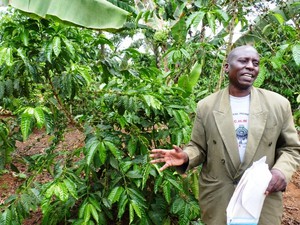Uganda: Fertilizer Use and Better Farming Methods Could Double Coffee Output
 By Staff Writer
By Staff Writer
KAMPALA--The use of inorganic fertilizers and improved farming practices by small-holder farmers can significantly increase, and even double, coffee production in Uganda -the world’s eleventh largest producer of the crop. This in turn would translate into more income and better lives for the estimated one-quarter of the population economically dependent on the crop in one way or another and a much-needed boost to the country’s export revenue.
This is according to a recent study conducted by researchers at the International Institute of Tropical Agriculture (IITA) which found that farmers of Robusta coffee in Southern Uganda who used Urea fertilizer to address the Nitrogen deficiency in their fields, harvested twice as much coffee beans as those that did not.
This applied both when the coffee was grown alone (monocropped) or mixed together with banana (intercropped), a common practice in the country and which a previous study by IITA showed increases incomes for farmers by as much as 50 per cent.
The study also found that the rate of return for farmers’ investment in fertilizer, using 2006 – 2007 prices, were as high as 545 per cent for Robusta grown together with banana and 305 per cent when grown alone.
However, yield increases and profitability of applying nitrogen fertilizer were much lower for Arabica coffee in the Mount Elgon area where the yield increased by an average of 36 per cent and the rate of return was below 100 per cent. However, a nutrient deficiency mapping in the region confirmed that the soils lacked other essential minerals and not just nitrogen.
According to Dr Piet Van Asten, a systems agronomist with IITA Uganda, the current average yield for both Arabica and Robusta coffee at one ton per hectare per year is very low but farmers can easily double their production by using fertilizer and improving current farming practices.
However, he says, to get the maximum return out of fertilizer use, it is important to target the nutrient deficiency in a particular area and the type of coffee instead of following blanket fertilizer recommendation.
“Arabica and Robusta coffee have different nutrient requirements and nutrient deficiencies vary from place to place. Yet the current fertilizer recommendations for the crop are not specific to the coffee type nor region,” he says.
Godfrey Senabulya, 45, from Bukomansimbi district in Uganda, was one of farmers involved in the study who is making much more money than before from his coffee farming by using fertilizer and improved farming practices. He started using fertilizers in 2006 after attending various trainings conducted under Agricultural Productivity Enhancement Program (APEP) funded by USAID in 2005 and 2006.
Senabulya says he is able to comfortably feed and educate his seven children with the earnings from coffee and has greatly improved his house and farm. He therefore advices farmers that good farming practices and the use of fertilizers pays. “Farmers should not be scared of using fertilizers. They should go for training to learn how and which fertilizers to use and they will see the difference,’ he says.
The low fertilizer usage was attributed to high fertilizer prices, poor supply, and differences in farmer resource endowments. The study showed that reduction in fertilizer prices and increase in coffee prices would make fertilizer use more acceptable even in Arabica growing region.
The research was funded by USAID through the Agricultural Productivity Enhancement Program (APEP). The study findings are also in line with a similar study led by van Asten and Lydia Wairegi, a PhD student at Makerere University which showed that moderate use of mineral fertilizers could double the production of East African highland bananas in Uganda.



